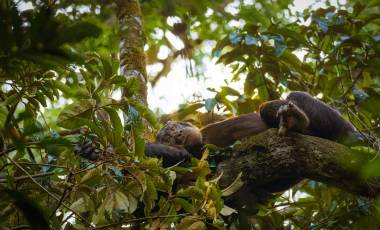Ninety-eight percent. That’s the number you’ll read or hear about as you prepare for tracking gorillas in Uganda. In 2012, after four years of research, geneticists from the U.K.’s Wellcome Trust Sanger Institute published a study declaring a 98% overlap between the human and gorilla genomes. “Most of our genes are very similar, or even identical to, the gorilla version of the same gene,” said a researcher.![]()
One look into the eyes of a gorilla in its natural habitat and you instinctively know this to be true. There’s something uncanny about the core resemblances that’s both deeply unsettling and profoundly reassuring.
But the options for observing a gorilla in its native environment are limited. This is especially the case for the critically endangered mountain gorilla, only 880 of which survive in the wild today, all of them hemmed into either the Virunga highlands or about 20 miles to the north, in Uganda’s Bwindi Impenetrable National Park.
It’s the 400+ gorillas in Bwindi that have drawn the most attention lately, and with good reason. Home to approximately half the world’s population of mountain gorillas, Bwindi also boasts a large number of “habituated” gorilla groups – those that, through careful, repeated exposure to humans, continue to behave normally even when people are nearby. These are some of the gorillas that travelers from around the world come to observe.![]()
Critical Conservation
Mountain gorilla protections that allow for both growing populations and carefully managed tracking are relatively new, but old enough to have proven their worth.
Until 1902, when German army Captain Friedrich Robert von Beringe presented the bones and skin of an ape he shot to document their existence, mountain gorillas were unknown in the Western world. They had lived unmolested by human diseases, traps or weapons for centuries. The misty highlands of east-central Africa were theirs, as yet unthreatened by expanding farms.
Slowly but surely, poaching, baby gorilla abductions, human and animal diseases, war and unrest, and the degradation or loss of habitat to rapidly growing human communities impacted the health of these uniquely large primates.
In the late 1980s, mountain gorilla numbers began to rebound, thanks in large part to Dian Fossey’s 18-year study of them and her creation of conservation practices that have since been pursued with vigor by the national park authorities in Rwanda, Congo and Uganda, as well as the Dian Fossey Gorilla Fund International, the International Gorilla Conservation Programme and their partners.
Habitat and wildlife conservation efforts continue to yield positive results today, despite high human population densities and severe poverty throughout the region.![]()
Rules of Engagement
In Bwindi, travelers gather every morning to hike into the jungle and gawk at their genetic cousins. But before plunging into the woods, a careful introduction by park staff makes clear some of the most important rules of thumb.
Primary among them is the need to keep at least seven meters from any ape to prevent the transmission of diseases. With so much genetic material in common, gorillas are known to be susceptible to human pathogens. In 1988, six mountain gorillas in Rwanda perished from a disease that looked a lot like measles. With the lives of 65 others at stake, veterinarians used dart guns to vaccinate them with a human serum. It worked. Careful enforcement of the seven-meter rule has minimized the impact of other diseases, as has constant monitoring. ![]()
During the pre-trek introduction, emphasis is placed on the controlled nature of the experience. Though your tracker/guide may machete a path through the dense underbrush, mountain gorilla habitat is fragile. It can absorb only so many human footprints. Also, the habituation of and respect for mountain gorilla groups are not taken lightly. In Bwindi, 10 different gorilla groups can be visited, but only for one hour per day and only by groups of eight people or less.
Even in their secure habitats at Bwindi, gorillas follow their own whims. Sometimes they’re easily reached, right at the forest’s edge. At others they’re deep in the woods, requiring several hours of trekking up and down steep, muddy slopes thick with primeval growth. But trackers know where they are, and visitors are 95% certain to meet the gorillas of Uganda. Of course, there’s much to admire along the way, including more primates and myriad endemic bird and butterfly species.
When you reach your gorilla group, you never know who will be visible or active. The dominant silverback may be snoozing out of sight, or bore a hole into your soul with his determined black-eyed gaze. The secondary blackback might lurk nearby, hidden but heedful, or perch purposefully right before you. The moms might take a moment to feed the youngsters, who otherwise tumble mischievously in the tangle of branches overhead.
Whatever the case, your unforgettable hour with these gentle-but-wild in-laws will pass in a flash. And the overwhelming desire to stay longer will give way to the persistent reminder from your guides that you’re a visitor and should not overstay your welcome.![]()
Fundamental Funds
The costs of maintaining gorilla-centered wildlife and ecological safeguards are significant. Responsibly managed conservation requires pressure at local and international levels, and involves research and education as much as it does protection and law enforcement.
As a high-value activity capable of generating significant revenue, tourism has been tapped to offset this heavy financial burden. At present, the hefty fees charged for tracking gorillas in Uganda cover the cost of park management, pay into community-development trust funds benefiting localities in the buffer zones surrounding parks, and contribute to the overall budget of the Uganda Wildlife Authority.
So, as expensive as a gorilla-tracking permit may seem, it’s more than just an expensive ticket to view animals in the wild. It is a contribution to the preservation of an imperiled habitat and its critically endangered inhabitants. As a thrilling added bonus, you’re invited to briefly witness the world you are helping to protect for future generations of human and primates alike.
